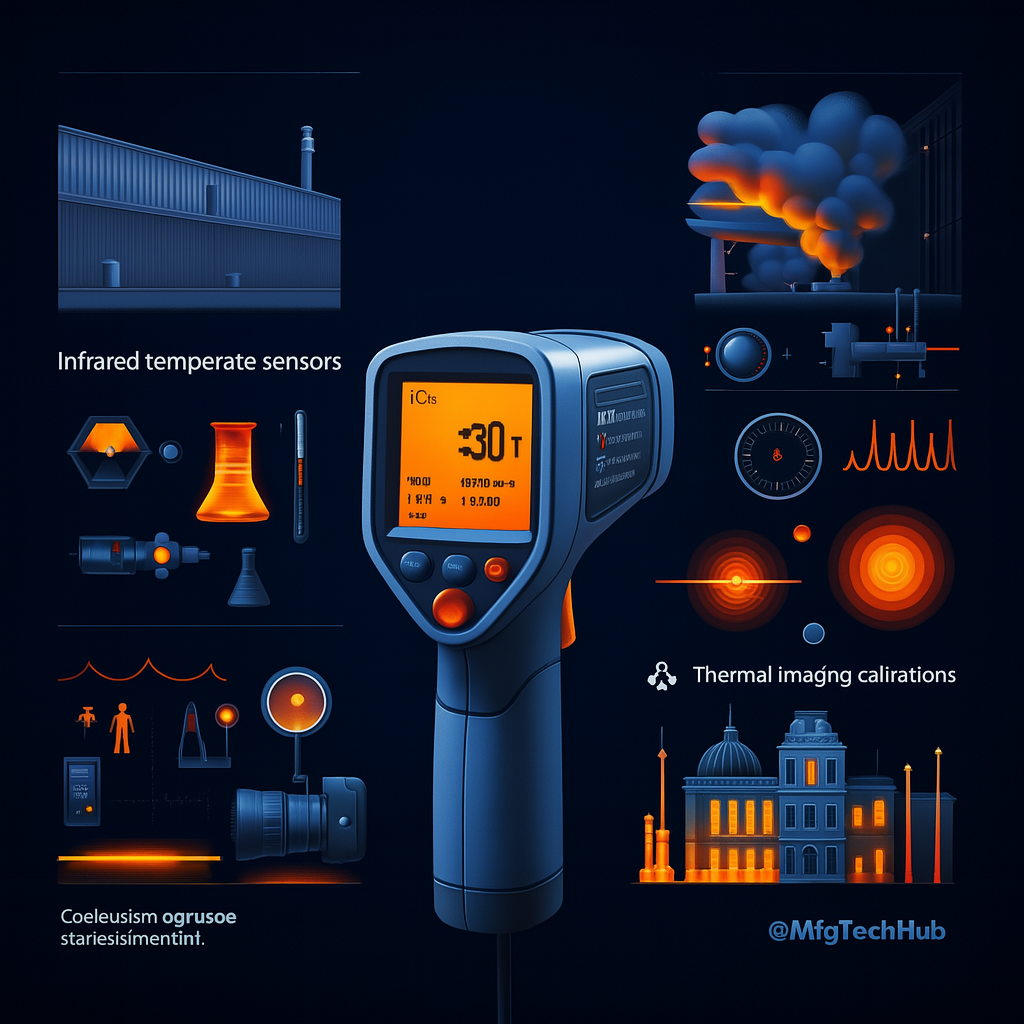Infrared Temperature Sensors and Thermal Imaging
Temperature measurement is a crucial aspect of industrial operations, ensuring process efficiency, safety, and quality control. While traditional contact-based sensors like thermocouples and RTDs are effective, they are not always suitable for measuring temperatures in moving objects, hazardous environments, or high-temperature industrial processes. This is where infrared temperature sensors and thermal imaging play a significant role.

Unlike contact-based sensors, these technologies allow for non-contact temperature measurement, making them ideal for industries such as manufacturing, healthcare, automotive, power generation, and food processing. By detecting emitted radiation instead of requiring physical contact, they provide unique advantages where speed, safety, and accuracy are critical.
What is an Infrared Temperature Sensor?
An infrared temperature sensor measures temperature by detecting the infrared radiation emitted by an object. All objects with a temperature above absolute zero (-273.15°C) emit infrared radiation. The intensity of this radiation is directly related to temperature, and the sensor converts it into a readable value without requiring direct contact. This makes it highly versatile for applications ranging from industrial furnaces to consumer-grade thermometers.
Why Are Infrared Temperature Sensors Used in Industrial Applications?
- Non-Contact Measurement – Allows temperature measurement from a safe distance, protecting operators and equipment.
- Fast Response Time – Provides almost instant readings, enabling real-time monitoring of fast-moving processes.
- Measures High Temperatures – Capable of detecting temperatures in extreme environments like kilns and furnaces.
- Safe for Hazardous Areas – Ideal in explosive, chemical, or electrically sensitive zones.
- Minimal Maintenance – With no moving parts or physical contact, sensors require little upkeep compared to traditional probes.
Types of Infrared Temperature Sensors
1. Spot Infrared Thermometers (Pyrometers)
These devices measure temperature at a single point on an object’s surface. They are portable, relatively inexpensive, and widely used in maintenance, HVAC, and electronics testing. However, they only provide limited information compared to imaging systems.
2. Infrared Line Scanners
Line scanners sweep across moving surfaces, such as conveyor belts, paper rolls, or sheet metal. They generate a temperature profile across the scanned line, ensuring uniformity in large-scale manufacturing operations.
3. Thermal Imaging Cameras
These advanced devices capture full-area thermal maps (thermograms). Instead of a single-point reading, operators see an entire image with color-coded temperature zones, making it easier to identify anomalies or hotspots quickly.
Applications of Infrared Temperature Sensors
1. Industrial Manufacturing
- Monitoring furnaces, kilns, and boilers in steel and glass industries.
- Ensuring uniform heating during ceramics production.
2. Electrical Maintenance & Power Systems
- Identifying overheated transformers, circuit breakers, or busbars.
- Preventing catastrophic failures by detecting anomalies early.
3. Automotive & Aerospace
- Measuring engine block and brake temperatures under load.
- Validating thermal performance of aerospace materials.
4. Healthcare & Medical
- Non-contact fever screening during pandemics.
- Early detection of circulatory issues using thermal diagnostics.
5. Food Processing & Storage
- Ensuring consistent cooking, baking, or freezing cycles.
- Maintaining safety by verifying cold-chain integrity.
What is Thermal Imaging?
Thermal imaging captures infrared radiation and visualizes it as a heat map (thermogram), showing real-time temperature variations. Unlike single-point sensors, thermal cameras reveal patterns and gradients that help diagnose complex systems at a glance.
How Does Thermal Imaging Work?
- Heat Radiation Detection: Sensors detect emitted infrared energy.
- Signal Conversion: The energy is translated into electronic signals.
- Color Mapping: Software applies colors to represent temperature ranges.
- Visualization: The final thermogram highlights hot and cold zones for analysis.
Applications of Thermal Imaging
1. Predictive Maintenance & Fault Detection
- Spotting failing bearings or motors before breakdowns.
- Identifying electrical hotspots invisible to the naked eye.
2. Building Inspection & Energy Audits
- Detecting poor insulation, moisture ingress, or air leaks.
- Optimizing HVAC efficiency through targeted repairs.
3. Fire Safety & Emergency Response
- Helping firefighters locate hidden flames through smoke.
- Improving rescue operations in dark or hazardous conditions.
4. Law Enforcement & Security
- Detecting suspects by body heat in low-visibility scenarios.
- Supporting search-and-rescue operations in wilderness or disaster zones.
Comparison of Infrared Temperature Sensors and Thermal Imaging
| Feature | Infrared Temperature Sensors | Thermal Imaging Cameras |
|---|---|---|
| Measurement Type | Single-point temperature | Full-area heat distribution |
| Ideal for | Machinery, food, power systems | Large-area inspection, predictive maintenance |
| Cost | Lower | Higher |
| Accuracy | High for single-point readings | Good for trends, less precise for exact values |
| Industrial Use | HVAC, electronics, automotive | Building audits, firefighting, aerospace inspections |
Calibration of Infrared Sensors and Thermal Cameras
For reliable performance, these devices require periodic calibration:
- Blackbody Calibration – Uses a reference object with a known, stable emissivity.
- Fixed-Point Calibration – Relies on physical temperature standards such as ice points or boiling points.
- Comparative Calibration – Matches sensor readings against a precision thermometer under controlled conditions.
Best Practices
- Position sensors correctly to avoid reflection or interference.
- Adjust emissivity settings based on surface material (e.g., metals, plastics).
- Schedule regular calibration for consistent accuracy.
- Shield sensors from steam, dust, or condensation where possible.
- Incorporate thermal imaging into preventive maintenance routines.
Future Trends
- AI Integration: Thermal data combined with machine learning will predict failures more accurately.
- IoT-Enabled Sensors: Wireless infrared devices will feed data into cloud-based monitoring systems.
- High-Resolution Imaging: Future cameras will capture finer details, improving defect detection.
- Augmented Reality (AR): Overlaying thermal data on physical equipment via AR glasses will aid technicians.
- Infrared Spectroscopy: Expanding applications in healthcare and material science.
Conclusion
Infrared temperature sensors and thermal imaging have moved from niche tools to mainstream technologies that underpin modern industrial efficiency and safety. Their ability to provide non-contact, fast, and precise temperature measurement makes them indispensable in sectors as diverse as aerospace, energy, healthcare, and food production. As industries embrace AI, IoT, and digital transformation, these tools will not only monitor but also predict and optimize performance, ensuring smarter, safer, and more sustainable operations worldwide.
